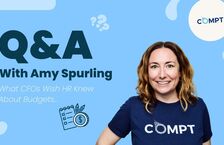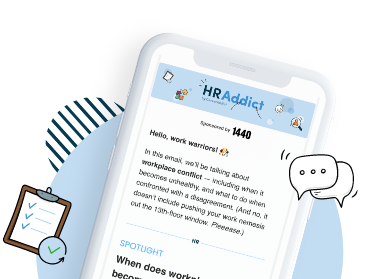This Q&A feature is written in collaboration with COMPT.
When it comes to allocating company budgets, every dollar counts. Whether it’s for talent management or resource funding, every decision needs clear communication.
We sat down (virtually) with Amy Spurling—the force behind Compt, an emerging leader in the employee benefits space—for an insightful Q&A on how HR leaders can navigate budget planning with strategy, confidence, and purpose.
With more than 20 years as a CFO and COO, Amy also shares insider tips on proposal approvals, what makes a budget request stand out, and why some great ideas still get the “no” stamp.
Q&A with Compt's Amy Spurling
Q #1: From your vantage point, what are the biggest misconceptions HR teams have about budgeting—and how can they better approach spending requests to get finance on board?
A: The biggest misconception isn’t actually from HR. It’s about HR.
Too many companies still treat HR as a cost center instead of a strategic function that protects and grows the business. HR isn’t asking for budget because culture feels good; they fund retention, productivity, and talent velocity.
The disconnect between HR and finance comes down to translation. HR often leads with impact on people, while finance needs to understand impact on the business.
When HR says, “This will improve engagement,” Finance hears, “This sounds expensive and hard to measure.” But when HR repositions that as, “This will reduce regrettable attrition by 15% and save $350K in backfill and ramp costs,” finance is suddenly very interested. It’s all about speaking the same language.
Budgets go to the clearest business case. HR gets what it needs when it shows cost, risk, forecast, and measurement in the same way every other function does.
Q #2: Beyond basic ROI, what factors most influence a CFO’s decision to approve or reject HR spend?
A: ROI is only one part of the story. As a CFO, I’m looking at a variety of things like:
Time to impact: Will this move the needle this quarter or next year?
Scalability: Does it create new process debt or can it scale with headcount?
Risk mitigation: Does this prevent churn, compliance issues, or burnout risk?
Operational efficiency: Does this save people time or eliminate manual work?
Strategic alignment: Does this match what the CEO and Board care about right now?
I don’t just want to fund a program. I want to fund momentum. If something helps us move faster or smarter, I’ll find the money. My team knows how to strike this balance, so when they come to me asking for budget, I rarely say no.
Q #3: In your experience, what types of HR initiatives tend to over- or under-deliver compared to expectations, and what lessons can finance and HR take from that?
A: The things that over-deliver are usually the ones HR can operationalize. Programs tied to manager enablement, internal mobility, performance clarity, and personalized benefits outperform because they reduce friction for employees and managers.
Anything launched without adoption behind it is what under-delivers. I’ve seen companies spend six figures on platforms no one uses because there was no rollout strategy, no ownership, and no accountability. Software isn’t a strategy. Without utilization, it’s just shelfware.
I’ve kept this in mind as we’ve built Compt, where we’ve seen 94% utilization on benefits when programs are structured clearly and built around real employee needs. The lesson here is not just to buy tools but to actually solve problems.
Q #4: As the year-end and 2026 planning approach, what timing considerations should HR keep in mind when preparing budget proposals?
A: The single biggest mistake HR makes is waiting too long. Budget conversations don’t start at year end. And oftentimes you want to clue in your stakeholders early on. In Q2, you should be gathering data, identifying gaps, and aligning with executive priorities. In Q3, you should be socializing proposals so you’re never a surprise line item. And by Q4, you should be negotiating and locking in execution plans.
If any department shows up at the end of the year with new proposals when the budget for the new year has likely already been set, it reads as reactive instead of strategic. And you’re way less likely to get me to budge. Early visibility builds trust and unlocks budget approval.
Q #5: How can HR better frame their spending proposals to align with broader strategic and financial goals, and what approaches have you seen work best?
A: Tie everything to a business priority. Every HR budget request should answer these three questions:
1. What business problem are we solving?
2. What happens if we do nothing?
3. How will we measure success?
If you can’t measure it, it won’t get funded. Showing cost is good, but showing cost of inaction is better. What’s the risk of us not finding budget for this initiative? Attrition, hiring delays, compliance risk (that’s a big one) — these are all business threats. HR is closest to these risks, so name them, quantify them, and lead the solution.
Q #6: How do economic and workplace trends—like uncertainty, labor shifts, and hybrid work—affect HR spending decisions, and what should HR consider when pitching budgets?
A: Economic uncertainty exposes bad strategy. If your programs only work in ideal conditions, they likely weren’t strategic to begin with. Right now, CFOs are funding things that improve productivity with small teams, retain critical roles during hiring freezes, support manager and individual contributor effectiveness, and protect culture and connection in distributed teams.
In tough times, CFOs will both reduce investment and reallocate it. If a proposal supports business durability, it gets funded.
Q #7: Once an HR initiative is approved, what metrics or dashboards do you want to see to track its success?
A: I want leading indicators (signals of adoption) and lagging indicators (business outcomes) to see success.
Examples of leading indicators would be participation/utilization, program launch timeline, manager adoption, and cost per employee.
Lagging metrics might look like retention lift, hiring velocity, productivity or time savings, cost avoidance, and internal mobility.
I want to see trendlines over activity reports. Impact is everything.
Q #8: From your viewpoint, what hidden risks do CFOs/finance often spot in HR spend, and how can HR address them upfront?
A: The risks that make CFOs nervous aren’t usually about total spend, but rather uncontrolled spend. HR budgets tend to include programs that start small but balloon over time, like variable costs tied to headcount, unchecked SaaS renewals, or outsourced services with unclear usage gaps. Finance is allergic to surprises.
Another red flag is proposals that lack ownership. If a new platform or initiative doesn’t have a clear owner who will drive adoption, measure outcomes, and report ROI, finance assumes it will become shelfware — and they’re often right.
HR can eliminate 80% of budget friction by getting ahead of these concerns early. That means presenting guardrails with the request (projected cost ceilings, usage assumptions, implementation accountability, and a defined path to efficiency). When HR leads with risk mitigation, finance stops seeing them as a cost center and starts seeing them as a strategic operator.
As a CFO, I don’t expect perfection; I expect control and clarity.
Q #9: With so many HR tech tools emerging, how do you decide if an investment is worth it, and what makes a business case stand out to finance?
A: Most HR tech fails not because the product is bad but because the problem it solves wasn’t clearly defined.
Finance isn’t looking for a flashy demo… have you seen accounting software?
We’re looking for proof that a tool moves a measurable metric tied to business performance. CFOs don’t buy software; we buy outcomes. So if a tool doesn’t clearly reduce risk, cut work, or improve retention, it doesn’t matter how “innovative” it is. It won’t get funded.
A strong business case starts with the problem:
- “We’re losing $600k annually due to manager turnover delays,” or
- “We’re spending 40 hours a week on manual approvals,” or
- “Employees are using only 12% of current benefits because the experience is broken.”
Now we’re having a real conversation about value.
At Compt, we see this firsthand. HR tech gets funded when it simplifies operations and pays for itself quickly. If an investment can show a clear path to break even in under 12 months and isn’t a burden to implement, it stands out immediately.
Q #10: Looking ahead into 2026 and beyond, how can HR make budget proposals both immediately impactful and future‑resilient?
A: The most effective HR leaders are building modular strategies — plans that deliver now and are built to scale. Instead of asking for a massive annual investment, they phase budget requests so they can prove impact fast, de-risk future asks, and build credibility with the finance team over time.
This is especially important in an uncertain economic market. Companies don’t have patience for long payback periods or theoretical returns. Budget proposals need to deliver visible momentum inside 90 days. That quarterly momentum builds trust, and trust is what unlocks future funding.
Resilient HR budgets also anticipate business change. If your proposal only works in ideal conditions or markets, it won’t survive planning season.
The future belongs to HR leaders who think like operators, who build business cases tied to workforce agility, efficiency, and long-term retention.
And when the business sees HR driving durability, not just programs, the conversation shifts. This is more than a “seat at the table.” It’s about being there to build the table you’re going to sit at. Then you move from “requesting budget” to “allocating capital with finance.” That’s the level we should all be playing at.
Parting thoughts
A strong HR budget comes from a strategic and resilient proposal that clearly links investments to measurable outcomes. When it aligns with business goals and is backed by data, you’re one step closer to securing the resources you need to drive meaningful impact. Show foresight, accountability, and value—these are the key traits of an HR team that’s not just managing costs but also fueling organizational growth.
Check out Compt's 2025 Midyear Lifestyle Benefits Benchmark Report for more insights and people-first benefits strategies, and make a real difference in employees’ lives.

